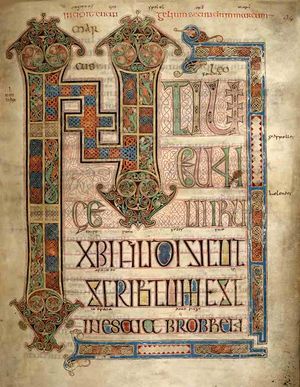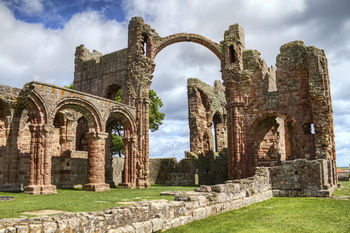Lindisfarne Priory: Difference between revisions
imported>Richard Nevell (Dissolution) |
imported>Richard Nevell (Add heading) |
||
| Line 18: | Line 18: | ||
In the 12th century the monks coined the term ''insula sacra'', meaning "Holy Island" which is now an alternative name for Lindisfarne.<ref>O'Sullivan & Young, ''English Heritage Book of Lindisfarne'', p. 12.</ref> | In the 12th century the monks coined the term ''insula sacra'', meaning "Holy Island" which is now an alternative name for Lindisfarne.<ref>O'Sullivan & Young, ''English Heritage Book of Lindisfarne'', p. 12.</ref> | ||
===Dissolution and later history=== | |||
Between 1536 and 1537 King [[Henry VIII]] began dissolving religious houses valued at less than £200. In 1535 Lindisfarne Priory's vale was assessed at £48, so it was amongst the first religious houses to be closed under the [[Dissolution of the Monasteries]]. Lindisfarne remained the property of the monastic community Durham, though they leased the island to the Crown.<ref name=Story39>Story, ''Lindisfarne Priory'', p. 39.</ref> In 1538 the shrine of St Cuthbert was broken open and his body was reputedly found to be "uncorrupt, with his face bare, and his beard as it had been a fortnight's growth".<ref>O'Sullivan & Young, ''English Heritage Book of Lindisfarne'', p. 59.</ref> Otherwise the buildings seem to have remained largely intact and at one point were used for storage. However, in 1613 the lead was removed from the church roof and the priory buildings fell permanently out of use and were allowed to lapse into a state of disrepair.<ref name=Story39/> | Between 1536 and 1537 King [[Henry VIII]] began dissolving religious houses valued at less than £200. In 1535 Lindisfarne Priory's vale was assessed at £48, so it was amongst the first religious houses to be closed under the [[Dissolution of the Monasteries]]. Lindisfarne remained the property of the monastic community Durham, though they leased the island to the Crown.<ref name=Story39>Story, ''Lindisfarne Priory'', p. 39.</ref> In 1538 the shrine of St Cuthbert was broken open and his body was reputedly found to be "uncorrupt, with his face bare, and his beard as it had been a fortnight's growth".<ref>O'Sullivan & Young, ''English Heritage Book of Lindisfarne'', p. 59.</ref> Otherwise the buildings seem to have remained largely intact and at one point were used for storage. However, in 1613 the lead was removed from the church roof and the priory buildings fell permanently out of use and were allowed to lapse into a state of disrepair.<ref name=Story39/> | ||
Revision as of 15:32, 1 April 2013
Lindisfarne Priory was founded in 635 on what is now known as Holy Island off the north east coast of England. It was abandoned in the 9th century after repeated Viking raids, but was re-established in the 12th century. The priory continued to be used until 1537 when it was dissolved. The ruins are now open to the public and under the care of English Heritage.
History
in the 7th century England was not a state, but a collection of small kingdoms. At this time Northumbria in the north east was the most powerful. Its population was pagan, but in 634 Oswald ascended to the throne. He had converted to Christianity in his youth and wanted his subjects to follow his lead. To encourage this, in 635 Oswald invited Aidan from the monastery on the island of Iona on the coast of Scotland to establish monastic community in Northumbria. The site chosen for this new foundation was Lindisfarne, a part-time (at high tide) island 10 miles from Bamburgh, the centre of Oswald's power.[1]
Based at Lindisfarne, Aidan was made a bishop and preached to the nobility of Northumbria. The first church on Lindisfarne dated from Aidan's time though it was replaced by his successor. A cemetery was established on the island, and Aidan's remains were interred there. According to Bede, Lindisfarne's monastic community had only buildings it needed to perform its religious duties and to get by, so though it was the seat of a bishop there was no high status accommodation. In the 685 a monk named Cuthbert, later canonised as a saint, was made bishop. His health failing him, in 687 Cuthbert became a hermit on the Inner Farne Island near Lindisfarne and gave instructions that he should be buried there. He died that year, but his remains were taken to Lindisfarne and interred in the church. A shrine to Cuthbert was created and it soon began a focus for pilgrims in northern England.[2]

The Lindisfarne Gospels were produced in the first quarter of the 8th century.
The popularity of the cult of St Cuthbert meant Lindisfarne Priory benefited from donations and grants. The priory's rising importance led to the creation of the Lindisfarne Gospels. In the first quarter of the 8th century the four Gospels were copied out in Latin. According to a 10th-century note added to the Lindisfarne Gospels, the 258-page document was copied out by Bishop Eadfrith while Bishop Ethilwald bound the book. Modern examination of the Lindisfarne Gospels suggest that the writing was the work of a single hand, suggesting the 10th-century story may contain some truth.[3]
In 737, King Ceolwulf of the Northumbrians retired to Lindisfarne. Eadberht assumed the throne after Ceolfulf, and in 750 laid siege to the church on Lindisfarne. The reason for the hostilities have since been lost, but the Bishop of Lindisfarne was taken prisoner. This was the first time soldiers had marched on Lindisfarne, but would not be the last. In 793 the Priory suffered a Viking raid. Contemporaries were appalled, believing that Northumberland's Christians must have sinned for St Cuthbert not to intercede. Vikings continued to pillage parts of Northumbria for years to come, and in 875 the monastic community uprooted themselves from Lindisfarne in search of a more secure home, taking with them the remains and relics of St Cuthbert.[4] The raid was the first securely documented Viking attack on Britain.[5]
In the 12th century the monks coined the term insula sacra, meaning "Holy Island" which is now an alternative name for Lindisfarne.[6]
Dissolution and later history
Between 1536 and 1537 King Henry VIII began dissolving religious houses valued at less than £200. In 1535 Lindisfarne Priory's vale was assessed at £48, so it was amongst the first religious houses to be closed under the Dissolution of the Monasteries. Lindisfarne remained the property of the monastic community Durham, though they leased the island to the Crown.[7] In 1538 the shrine of St Cuthbert was broken open and his body was reputedly found to be "uncorrupt, with his face bare, and his beard as it had been a fortnight's growth".[8] Otherwise the buildings seem to have remained largely intact and at one point were used for storage. However, in 1613 the lead was removed from the church roof and the priory buildings fell permanently out of use and were allowed to lapse into a state of disrepair.[7]
As early as the 18th century the ruined priory was attracting tourists and interest from antiquarians. Lindisfarne Priory remained in the hands of the Crown until it was sold to the Shelby family who owned parts of the island.[9] A small village was established on the island, close to the priory, though it is uncertain when it originated. Little is known about the residents' activity, though they were active agriculturally and supported the abbey through fishing. Fishing remained an important industry for the island's inhabitants after the priory was dissolved. From the 19th century tourism became increasingly important and now Holy Island's economy is based mainly around catering to people visiting Lindisfarne's priory and castle.[10] Today, Lindisfarne Priory is open to the public and under the care of English Heritage.[11]
References
- ↑ Story, Joanna (2005). Lindisfarne Priory. London: English Heritage. pp. 21–22. ISBN 978-85074-943-2.
- ↑ Story, Lindisfarne Priory, pp. 23–27.
- ↑ Story, Lindisfarne Priory, p. 28.
- ↑ Story, Lindisfarne Priory, pp. 30–31.
- ↑ O'Sullivan, Deidre & Young Robert (1994), English Heritage Book of Lindisfarne: Holy Island. London: B. T. Batsford and English Heritage. p. 11. ISBN0-7134-7307-X.
- ↑ O'Sullivan & Young, English Heritage Book of Lindisfarne, p. 12.
- ↑ 7.0 7.1 Story, Lindisfarne Priory, p. 39.
- ↑ O'Sullivan & Young, English Heritage Book of Lindisfarne, p. 59.
- ↑ Story, Lindisfarne Priory, pp. 39–40.
- ↑ Beavitt, Paulp (1995). “The island community” in O'Sullivan, Deidre & Young Robert (1994), English Heritage Book of Lindisfarne: Holy Island. London: B. T. Batsford and English Heritage. pp. 104–106, 113–114. ISBN0-7134-7307-X.
- ↑ "Lindisfarne Priory", English Heritage, accessed 21 March 2013.
